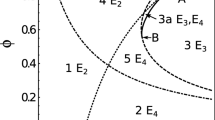Abstract
In this paper we study the uniform persistence (UP) of an association of two competing host species sharing a directly transmitted macroparasite. Like predators, parasites can regulate UP while the hosts are either coexisting or in a dominance relationship without any infections, but cannot regulate UP in case the hosts are in bistability. The regulatory mechanism depends on the relationships between the parameters, such as host intrinsic growth rate, host carrying capacity, susceptibility, parasite pathogenicity and the magnitude of parasite aggregation. In the case of coexistence the parametric space for UP is more than that for global stability of the host-parasite equilibrium, but is less than that for UP in the case of dominance. In the case of dominance, the parasites can alter the competitive outcome locally or can enhance the local exclusion of the inferior competitor and thus, unlike the predation, parasitism has an beneficial effect over competition. We derive explicitly the range of the values of ratios of the rates of reproduction and survivorship of the hosts, and also of the values of the degree of aggregations, with which macroparasites are not effective in maintaining its beneficial effect over competition. Finally our results support the body-size hypothesis of Price et al. (1988), with possible explanations of certain exceptional examples of the hypothesis.
Similar content being viewed by others
References
Anderson, R. M. and R. M. May (1978). Regulation and stability of host and parasite population interactions I. Regulatory processes. J. Animal Ecol. 47, 219–249.
Anderson, R. M. (1979). Parasite pathogenicity and the depression of host population equilibria. Nature 279, 150–152.
Anderson, R. M. and R. M. May (1981). The population dynamics of microparasites and their invertebrate hosts. Phil. Trans. R. Soc. B291, 451–524.
Barbehenn, K. R. (1965). Host-parasite relationships and species diversity in mamals: An hypothesis. Biotropia 1, 29–35.
Begon, M., R. G. Bowers, M. Kadianakis and D. E. Hodgkinson (1992). Disease and community structure: the importance of host self-regulation in a host-host-pathogen model. Amer. Nat. 139, 1131–1150.
Butler, G. and P. Waltman (1986). Persistence in dynamical systems. J. Diff. Eqns 96, 425–430.
Burdon, J. J. and G. A. Chilvers (1977). The effect of barley mildew on barley and wheat competition in mixtures. Aust. J. Bot. 25, 59–65.
Freeland, W. J. (1983). Parasites and the coexistence of animal host species. Amer. Nat. 121, 223–236.
Hale, J. K. (1969). Ordinary Differential Equations. New York: Wiley-Interscience.
Hofbauer, J. and K. Sigmund (1988). Dynamical Systems and The Theory of Evolution. Cambridge: Cambrige University Press.
Holt, R. D. and J. Pickering (1985). Infectious diseases and species coexistence: a model of Lotka-Volterra form. Amer. Natur. 126, 196–211.
Hutson, V. and K. Schmitt (1992). Permanence and the dynamics of biological systems. Math. Biosci. 111, 1–71.
Hutson, V. and G. T. Vickers (1983). A criterion for permanent coexistence of species, with an application to a two-prey, one-predator system. Math. Biosci. 63, 253–269.
Krivan, V. and A. Sikder (1998). Optimal foraging and predator-prey dynamics II. Theor. Pop. Biol. (in press).
Lancinani, C. A. (1975). Parasite induced alterations in host reproduction and survival. Ecology 65, 689–695.
May, R. M. and R. M. Anderson (1978). Regulation and stability of host-parasite population interactions. II. Destabilising processes. J. Animal Ecol. 47, 249–268.
Park, T. (1948). Experimental studies of interspecies competition. I. Competition between populations of the flour beetles, Tribolium confusum duval and Tribolium castaneum Herbst. Ecol. Monogr. 18, 265–308.
Price, P. W. (1980). Evolutionary biology of parasites. Princeton, NJ: Princeton University Press.
Price, P. W., M. Westoby and B. Rice (1988). Parasite-mediated competition: some predictions and tests. Amer. Nat. 131, 544–555.
Schrag, S. J. and J. E. Mittler (1996). Host-parasite coexistence: the role of spatial refuges in stabilizing bacteria-phage interactions. Amer. Nat. 148, 384–377.
Sikder, A. and A. B. Roy (1994a). Multiple cyclic sets connecting saddle points and limit cycles of a four species system and its uniform persistence. Math. Biosci. 121, 141–154.
Sikder, A. and A. B. Roy (1994b). Persistence of a generalised gause-type prey predator pair linked by competition. Math. Biosci. 122, 1–23.
Yan, G. (1996). Parasite-mediated competition: a model of directly transmitted macroparasites. Amer. Nat. 148, 1089–1112.
Author information
Authors and Affiliations
Rights and permissions
About this article
Cite this article
Sikder, A. Effects of parasitism over two competing host populations leading to persistence. Bull. Math. Biol. 61, 179–205 (1999). https://doi.org/10.1006/bulm.1998.0087
Received:
Accepted:
Issue Date:
DOI: https://doi.org/10.1006/bulm.1998.0087




